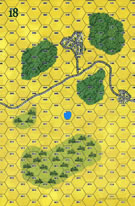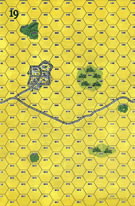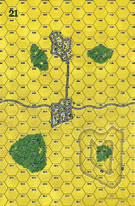|
Final Counter Attack Road to Berlin #50 |
||
|---|---|---|
| (Attacker) Germany | vs | Soviet Union (Defender) |
| Formations Involved | ||
|---|---|---|
| Germany |  |
20th Motorized Infantry Division |
| Soviet Union |  |
301st Rifle Division |

| Total | |
|---|---|
| Side 1 | 0 |
| Draw | 0 |
| Side 2 | 1 |
| Overall Rating, 1 vote |
|---|
|
3
|
| Scenario Rank: --- of 913 |
| Parent Game | Road to Berlin |
|---|---|
| Historicity | Historical |
| Date | 1945-03-27 |
| Start Time | 07:00 |
| Turn Count | 36 |
| Visibility | Day |
| Counters | 100 |
| Net Morale | 1 |
| Net Initiative | 2 |
| Maps | 3: 18, 19, 21 |
| Layout Dimensions | 84 x 43 cm 33 x 17 in |
| Play Bounty | 118 |
| AAR Bounty | 171 |
| Total Plays | 1 |
| Total AARs | 1 |
| Battle Types |
|---|
| Road Control |
| Rural Assault |
| Urban Assault |
| Conditions |
|---|
| Off-board Artillery |
| Scenario Requirements & Playability | |
|---|---|
| Road to Berlin | Base Game |
| Introduction |
|---|
|
With Soviet armies storming over the Oder River, the last natural barrier in front of Berlin, Adolf Hitler projected a series of counter-attacks to drive them back. Knowing this to be a doomed enterprise, the command staff at German Ninth Army sent four divisions out of the Frankfurt bridgehead anyway, hoping to keep the Soviets off balance a little longer. |
| Conclusion |
|---|
|
The German panzers did surprisingly well, taking their initial objectives and sowing confusion in the Soviet ranks. The Soviets, for their part, appear to have assumed the German command would never be so insane as to throw away their last panzer reserves in such a cavalier manner. While the German tanks advanced, their accompanying infantry fell victim to massed enemy artillery and rocket fire. "The attack was a massacre," army group commander Col. Gen. Gotthard Heinrici, the "Poisonous Dwarf," raged to his staff. "The Ninth Army has suffered incredible losses for almost nothing." |
| AFV Rules Pertaining to this Scenario's Order of Battle |
|---|
|
| 5 Errata Items | |
|---|---|

|
The reduced direct fire value of the Heer HMG became 5-5 starting with Fall of France. (plloyd1010
on 2015 Jul 31)
|

|
The morale and combat modifiers of German Sergeant #1614 should be "0", not "8". (Shad
on 2010 Dec 15)
|

|
All SPW 251s have an armor value of 0. (Shad
on 2010 Dec 15)
|

|
Liberation 1944's Tiger movement and armor ratings are backwards. They should be Armor 7 and Movement 5. (petermc
on 2014 Feb 14)
|

|
The reduced direct fire value in Kursk: Burning Tigers is 4-4. (plloyd1010
on 2015 Jul 31)
|
| Next Time We'll Bring Some Ammo | ||||||||||||
|---|---|---|---|---|---|---|---|---|---|---|---|---|
The German plan for this action was fairly straightforward: Divide into two battle groups and hit the two towns on board 21 at the same time. Once the towns were cleared, assess the remaining Soviet defenses and allocate the necessary force to hit Soviet support units while the rest began clearing the east-west road. It all went according to plan-- until the middle of the first turn. If this site ever adds a "Rotten Turn Hall of Fame," I would humbly submit the German first turn of this action for an early induction. As German units approached down the road, OBA was called in to chase a Soviet artillery spotter off the 40M hill on board 21. It failed to do so, but did manage to run the German OBA out of ammo for the rest of the action. Meanwhile the Soviets countered with devastating OBA of its own, which first demoralized the German CO (no small matter for a 10-1-2 LTCOL!) and then eliminated him with another failed morale check. As a final insult, the Fog of War rolled in early, before the Germans completed their initial deployment. In the ensuing chaos among the German ranks, the Soviets developed their trademark defense for the entire action: Pick a position with a lot of German GRENS, and pour down a crippling bombardment, and keep hammering the position in subsequent activations until there were less GREN units on the board. Given the Soviet OBA and mortar units, this would have been easy enough. Add to it the 76's being used for bombardment value, and the German GRENS were unable to move in open territory without horrific results. Meanwhile, the Soviet INF and AT units waited in the towns and surrounding woods as a first line of defense with more INF defending the length of the road and its approaches. Meanwhile, the surviving Germans opted for Plan B: a strike in force at the northern town on map 21 and the surrounding woods, and strike south for the central town and the road to its east. Again, German plans were hampered and delayed by Soviet OBA. In not quite three hours, the Soviets had eliminated enough German units to give them a major victory. I stopped to assess the situation: Had the Germans made enough headway to justify continuing? Reluctantly, I decided that they had and continued the battle. Once past the towns, the situation changed for the Germans. They had penetrated the Soviet first line of defense and advanced on the weaker inner defenses. The German armor pulled off the astounding feat of eliminating the Soviet 76's with the loss of only one step of their own. But the Soviets, getting more desperate, pulled off ever more astounding feats of courage of their own. This is best exemplified by the INF and HMG unit that assaulted a Tiger unit. Its survivors could brag how they brought down a step of Tiger tanks and sent the remnants reeling back demoralized. The Soviets withdrew from the center town to defend the road to the east. Their AT was destroyed, but their ground troops ready to assault the oncoming German panzers. The panzers, already pulling double duty from the loss of OBA, were further hamstrung from the appalling loss of GRENS. The action was rapidly turning into a pointless slugging match. In mid-afternoon, the Germans conceded to the reality of the situation. The survivors of the day began to withdraw. This was a hard action to rate, given the loss of German OBA and leadership in the first turn. I try to imagine how much difference it would have made considering the tremendous amount of artillery, both offboard and onboard, that the Soviets had. I don't think it would have made too much of a difference, except to maybe prolong the German agony even longer. I therefore charitably rated the scenario a 3. |
||||||||||||
| 0 Comments |

 RtBr049
RtBr049 

























